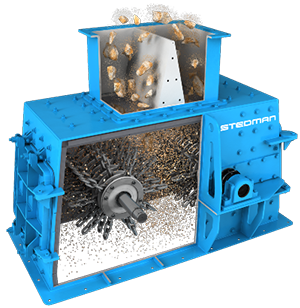Chain Mill Crusher Overview
You’re crushing it, but why bring the proverbial sledgehammer when a simpler machine will do? Chain mills represent a cost-effective crushing solution for reducing a wide variety of materials.
What is a chain mill?
Chain mills are designed for rapid, uniform, and economical reduction, in open or closed circuit, of loosely bound agglomerates and other sticky materials with a minimum of clogging. These machines are particularly effective as a fertilizer crusher since the chain mill is designed to break up lumps in superphosphate, triple-superphosphate, granular, and conventional fertilizer tailings. You can also find chain mills in the production of animal bedding, sawdust, and other clumping materials.

How does a chain mill work?
A series of chain links, rotated at high velocity reduce particle size by impacting the material. For most friable materials, the chain mill produces a consistent discharge particle size distribution largely independent of the feed particle size distribution. It produces few fines or finely broken material. This mill easily handles material that tends to cake or clog. The efficiency of the mill means it requires less recirculation in closed-loop configuration to meet size reduction requirements.
Design
Efficiency comes from the correct rotor velocity and the configuration of the rotor chains. The proper chain spacing allows the material to fall lower into the path of the chain links before being impacted. A counter-rotating dual-rotor configuration causes multiple impacts of the material to accelerate it as it moves down through the mill. The open interior design allows foreign materials to pass easily through the mill.
The mill is simply constructed of welded plate steel and bolted assembly, yet it is rugged so that it will maintain long use with little adjustment, repairs, or wear part replacement. Chain mill rotors are balanced, and little vibration of the chain mill housing is noticeable during normal operating conditions.
No screen is required to maintain the material in the grinding zone until it is reduced to a specified size. The elimination of a screen permits reduction of many materials, which would clog a screen. In the fertilizer industry, it’s not practical to use grates or sizing screens because of the choking and clogging characteristics of the material.
Configurations
The simplest single rotor design has its shaft supported on both sides of the housing by bearing supports. A chain curtain at the impact end has controlled swinging action. Some single rotor chain mills feature a coarse vertical screen at the impact end instead of a chain curtain. Keep in mind, the screen or chain curtain isn’t to limit top size material as in a hammer mill; it acts as an anvil.
In the double counter-rotating design, as the one illustrated, the shafts are supported on both sides as well. The two independent chain rotors rotate in opposite directions forcing material quickly through the mill
Cantilever designs place all of the mechanical parts on one side of the crusher. There is also a single rotor, vertical shaft cantilevered design that feeds material from the top. It falls through the mill as the rotating chains crush it.
Capacity
The chain mill comes in just about any size required and can handle from 5 to over 600 tons of material per hour, with virtually no possibility of plugging or clogging. Speeds of up to 1500 RPM are typical, depending on fineness required. Rotor widths range from 15 to 42 in., according to the capacity required, and single or double 7.5- to 120-hp electric motors are typical.
Operation and Maintenance
The chain mill is forgiving of normal wear and tear. It’s relatively inexpensive to maintain, needing only routine replacement of chain links or liner material. Large doors on the chain mill and the open interior design allow easy access to all parts of the mill for inspection and maintenance. Chain links and wear-resistant impact liners can be inspected without having to disassemble any part of the chain mill.
Why choose chain mills?
For a low-cost, highly efficient crusher for soft, clumping, or agglomerate material, the chain mill can’t be beaten.
Chris Nawalaniec is vice president of sales and marketing at Stedman Machine Co.
